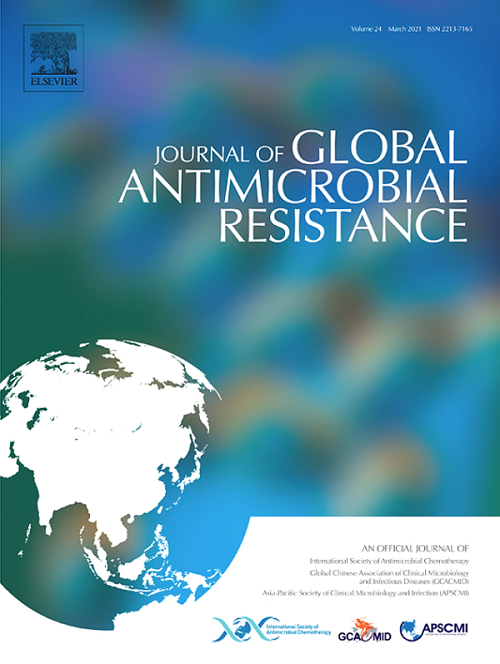Drug-resistance patterns and associated mutations of Mycobacterium tuberculosis strains isolated from chronic kidney disease and diabetes mellitus patients in Ethiopia
IF 3.2
3区 医学
Q2 INFECTIOUS DISEASES
引用次数: 0
Abstract
Objective
To assess the drug-resistance (DR) patterns, mutations, and associated factors among tuberculosis (TB) cases identified from diabetes mellitus (DM) and chronic kidney disease patients.
Methods
The DR patterns of 77 Mycobacterial isolates were assessed using phenotypic drug-susceptibility testing, the Xpert MTB/rifampicin (RIF) assay, the Xpert MTB/XDR assay, and line probe assays. Data were analysed using SPSS version 27. Descriptive statistics, a chi-squared test, and logistic regression were conducted. The 95% CI was determined, and a P-value <0.05 was considered a statistically significant difference.
Results
Resistance pattern was determined for 76 Mycobacterial isolates, and one isolate had an invalid result. Any DR and multi-DR were detected among 25.0% (19), and 7.9% (6) isolates, respectively. Resistance to streptomycin, isoniazid (INH), RIF, ethambutol, and pyrazinamide was 11.8% (9), 13.2% (10), 10.5% (8), 6.6% (5), and 11.8%(9), respectively. Mono-DR was detected for streptomycin 3.9% (3), INH 2.6% (2), RIF 2.6% (2), and pyrazinamide 4.5% (4). One isolate was resistant to fluoroquinolones. Phenotypic and genotypic methods had concordant results in determining RIF and fluoroquinolones resistance. The common RIF and INH-resistant conferring mutations were observed at the S531L and S315T regions, respectively. Previous TB treatment and TB contact history were associated with DR-TB.
Conclusions
A quarter of TB cases identified had DR-TB, with a higher risk among patients with previous TB treatment history and had contact with TB patients, necessitating programmatic interventions, including applying infection prevention, contact tracing, and access to drug-susceptibility testing using rapid molecular methods.
埃塞俄比亚慢性肾病和糖尿病患者结核分枝杆菌菌株的耐药模式和相关突变
目的:了解糖尿病(DM)和慢性肾脏疾病(CKD)患者结核(TB)的耐药模式、突变及其相关因素。方法:采用表型药敏试验(DST)、Xpert MTB/RIF法、Xpert MTB/XDR法和线探针法对77株分枝杆菌分离株的耐药模式进行评价。数据分析采用SPSS 27版。进行描述性统计、卡方检验和逻辑回归。结果:确定了76株分枝杆菌的耐药模式,1株结果无效。分别有25.0%(19株)和7.9%(6株)耐药和多重耐药。对链霉素(STR)、异烟肼(INH)、利福平(RIF)、乙胺丁醇和吡嗪酰胺(PZA)的耐药率分别为11.8%(9)、13.2%(10)、10.5%(8)、6.6%(5)和11.8%(9)。STR为3.9% (3),INH为2.6% (2),RIF为2.6% (2),PZA为4.5%(4)。1株对氟喹诺酮类药物(FLQ)耐药。表型和基因型方法测定RIF和FLQ抗性的结果一致。在S531L和S315T区域分别观察到常见的RIF和inh抗性突变。既往结核治疗和结核接触史与耐药结核相关。结论:在已确定的结核病病例中,有四分之一有结核病治疗史并与结核病患者有过接触的患者患有耐药结核病,其风险较高,因此需要采取有规划的干预措施,包括应用感染预防、接触者追踪和使用快速分子方法获得DST。
本文章由计算机程序翻译,如有差异,请以英文原文为准。
求助全文
约1分钟内获得全文
求助全文
来源期刊

Journal of global antimicrobial resistance
INFECTIOUS DISEASES-PHARMACOLOGY & PHARMACY
CiteScore
8.70
自引率
2.20%
发文量
285
审稿时长
34 weeks
期刊介绍:
The Journal of Global Antimicrobial Resistance (JGAR) is a quarterly online journal run by an international Editorial Board that focuses on the global spread of antibiotic-resistant microbes.
JGAR is a dedicated journal for all professionals working in research, health care, the environment and animal infection control, aiming to track the resistance threat worldwide and provides a single voice devoted to antimicrobial resistance (AMR).
Featuring peer-reviewed and up to date research articles, reviews, short notes and hot topics JGAR covers the key topics related to antibacterial, antiviral, antifungal and antiparasitic resistance.
 求助内容:
求助内容: 应助结果提醒方式:
应助结果提醒方式:


